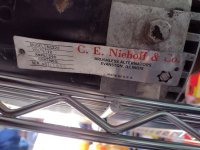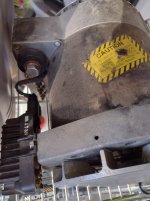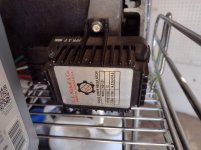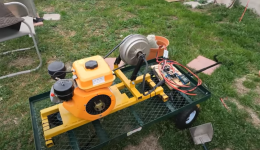spinningmagnets
100 TW
This video uses a $200 "Predator" gasoline engine similar to a lawn mower engine. The car alternator is a common 100A unit for $100.
It may help to understand the difference between 1950's car generators and what is now called an alternator. The old style generators made 14V at cruise RPM's as you drove down the road, but...when the car was idling, the voltage was lower, and the headlights would "dim". If you idled too long with the headlights on, it would drain down the battery and it might be difficult to start later.
There was a desire for a generator of some type that would put out the full 14V at idle RPM's. What ended up working is using electromagnets in the rotor/armature. The system is designed to put out 14V at idle, and as the RPM's increase, the voltage would normally increase too, but...a small voltage-regulator scales the power to the rotor downwards, so the electromagnets get weaker. In this way, the alternator makes 14V at all RPM's.
By removing the voltage-regulator and connecting the rotor-windings power directly to the systems 14V, I have seen a car alternator produce 120V DC by adjusting the RPM's. By using a belt and pulleys between the engine and alternator, the diameter of the pulleys can be adjusted to produce 48V at the optimum engine RPM.
The AlternatorGenerator, 48V Battery Charging
It may help to understand the difference between 1950's car generators and what is now called an alternator. The old style generators made 14V at cruise RPM's as you drove down the road, but...when the car was idling, the voltage was lower, and the headlights would "dim". If you idled too long with the headlights on, it would drain down the battery and it might be difficult to start later.
There was a desire for a generator of some type that would put out the full 14V at idle RPM's. What ended up working is using electromagnets in the rotor/armature. The system is designed to put out 14V at idle, and as the RPM's increase, the voltage would normally increase too, but...a small voltage-regulator scales the power to the rotor downwards, so the electromagnets get weaker. In this way, the alternator makes 14V at all RPM's.
By removing the voltage-regulator and connecting the rotor-windings power directly to the systems 14V, I have seen a car alternator produce 120V DC by adjusting the RPM's. By using a belt and pulleys between the engine and alternator, the diameter of the pulleys can be adjusted to produce 48V at the optimum engine RPM.
The AlternatorGenerator, 48V Battery Charging
Last edited:





